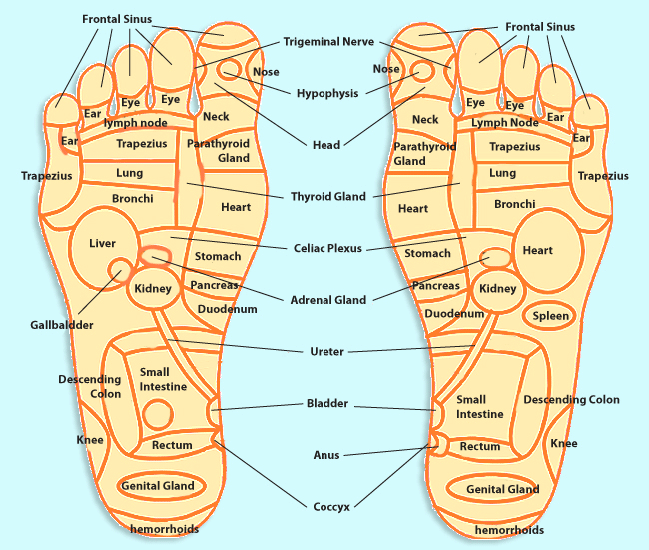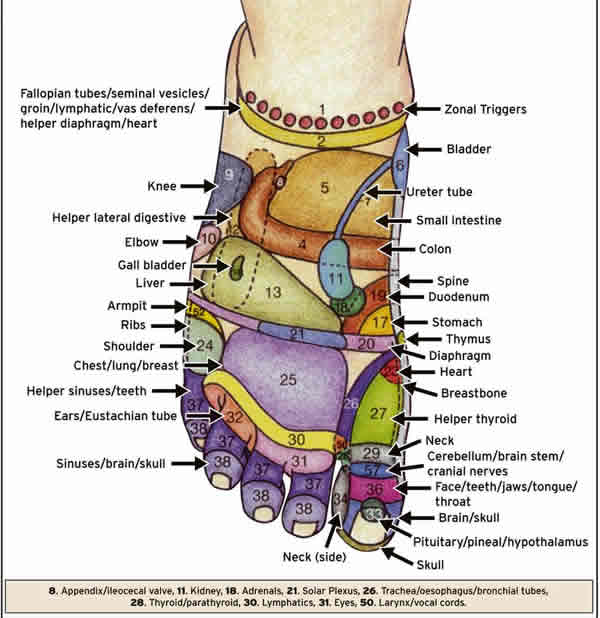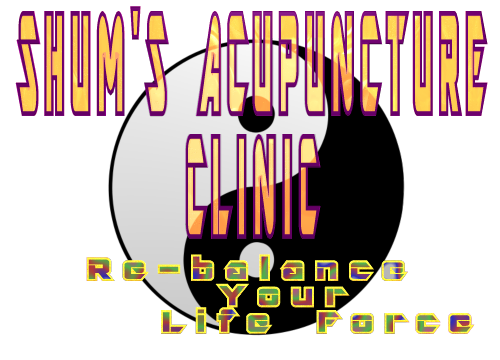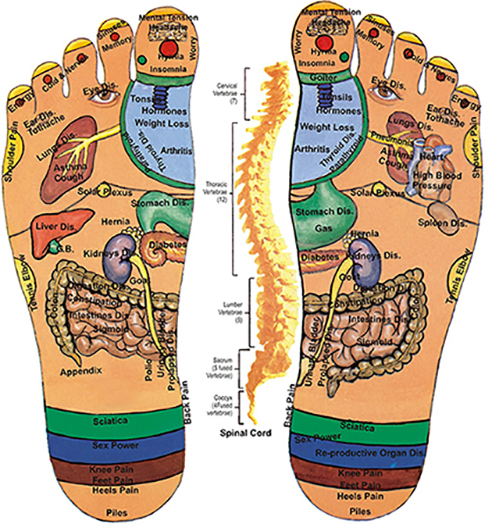The recognition of reflexology as a specific type of treatment began with Zone Theory, in which the body is divided into 10 vertical zones. Each zone corresponds to fingers and toes all the way up to the top of the head. For example, if you are standing up with your hands on your thighs (palms facing down) the thumbs and great toe would be zone 1. On either side of the body, the index finger and second toe would be zone 2, etc.
In reflexology theory, every organ, valve, muscle, etc. that lies within a zone can be accessed via a point or area on the feet or hands. For example, working between toes 2 and 3, or fingers 2 and 3, the eye point is found. These pathways between pressure points and other parts of the body are thought to be connected via the nervous system.
Research studies in the U.S. and around the world indicate possible benefits of reflexology, particularly in reducing pain, enhancing relaxation, and reducing psychological symptoms, such as anxiety and depression.
One large review by Kunz and Kunz (2008) summarized 168 research studies and abstracts from journals and meetings from around the world. Many of these studies originated in peer-reviewed journals in China and Korea. All of the studies had information about the frequency and duration of the reflexology application. Based on the studies they reviewed, Kunz and Kunz concluded that reflexology may:
✔ Impact specific organs
For example, fMRI readings demonstrated an increase in blood flow to kidneys and to the intestines.
✔ Improve symptoms
In particular, positive changes were noted in kidney functioning with kidney dialysis patients.
✔ Induce relaxation
Though EEG measurements of alpha and theta waves, researchers saw that blood pressure was decreased, and anxiety was lowered.
✔ Reduce pain
Twenty-seven studies demonstrated a positive outcome for reduction in pain; e.g., AIDS, chest pain, peripheral neuropathy of diabetes mellitus, kidney stones, and osteoarthritis.
Kim, Lee, Kang, Choi, and Ernst (2010) reviewed one randomized clinical trial (RCT) and three nonrandomized controlled clinical trials (CCTs), the only studies out of 60 potential studies to meet their criteria of controlled quantitative trials with physical or psychological outcomes. The studies showed significant reduction in pain, nausea/vomiting, and fatigue with reflexology, and improved sleep and mood. In short, all four studies suggested beneficial effects of reflexology for women with breast cancer.
www.takingcharge.csh.umn.edu/explore-healing-practices/reflexology/what-does-research-say-about-refloxology

Insomnia is the most commonly reported sleep problem in industrialised nations worldwide. It is characterised by an inability to initiate or maintain sleep for a sufficient amount of time during regular sleeping hours and is associated with a complaint of daytime dysfunction. Acute insomnia is defined as sleep difficulty lasting one night to a few weeks in duration. Chronic insomnia is defined as sleep difficulty lasting at least three nights per week for 1 month or more. The prevalence of insomnia in the general population is approximately 35%, with 10–15% of this being moderate to severe insomnia. Prevalence rates for chronic insomnia are found to be generally higher in women and increasing with age.
Present treatment falls into two main categories, pharmacological and non-pharmacological. Pharmacological consists of prescribed and non-prescribed hypnotics and sedatives. Non-pharmacological treatment consists mainly of behavioural and cognitive therapies. Unfortunately, doctors in general practice often lack the necessary evaluation skills and awareness of non-pharmacological treatment, and so an attitude of medication or nothing, in some cases, has arisen. Due to these factors, many insomniacs seek complementary and alternative medicine (CAM) to alleviate their condition, and as a result insomnia has become one of the top five conditions treated by CAM.
dx.doi.org/10.1136/aim.2009.000760
There is no specific reflex point for sleep, so areas of the central nervous system, and the thyroid, pineal and pituitary glands, are emphasised towards increased stimulation. Treatments in reflexology involved the use of a standardized base oil carried out by Dr. Chan, an experienced reflexologist.


